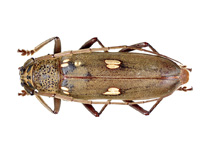Abstract
Available mitochondrial DNA sequences viz., 16S, Cyt b, Cyt c oxidase subunit – I, and Cyt c subunit-like – I gene of Rhynocoris (Kolenati) species were subjected to phylogenetic analysis to understand the intrageneric and intraspecific variations and the role of geographical isolation on speciation; using CLUSTAL W in MEGA version 5.1. This analysis includes fifteen species and four ecotypes of R. kumarii Ambrose and Livingstone and three morphs of R. marginatus (Fabricius) from four countries viz., Canada, China, Korea, and South Africa. The pairwise genetic distances were calculated and phylograms were constructed using Maximum Likelihood, Maximum Parsimony, and Neighbor-Joining methods. These preliminary analyses not only demarcated the fifteen species of Rhynocoris, the four ecotypes of R. kumarii, and the three morphs of R. marginatus, but also revealed phylogenetic relationships and the role of geographical isolation and polymorphism on speciation.

